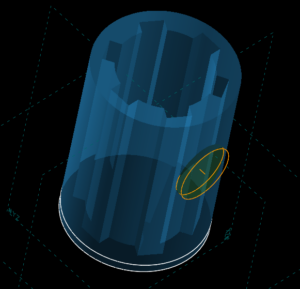This is an update to an earlier post Adding a Tachometer to a Grizzly Mill. Initially, the magnet for the tachometer was taped to the top of the mill spindle. Over time, I got tired of re-installing it every time I used the quill feed for drilling. This enhancement is a drawbar cover that sits on the top of the spindle/quill. The magnet is mounted on the outside of this. Whenever the quill feed needs to be used, simply remove the cover.
MCAD Design
Using SolveSpace, the following design was created.

Note the recess in the sidewall to hold the 12 mm x 1.5 mm magnet.

The interior is notched to fit over the drawbar, shown here.

The printed model.
The design files can be found at Printables.
Installation
For the initial install, I just attached the magnet with a single wrap of clear packing tape.

Slide the cover on.

Happy milling!